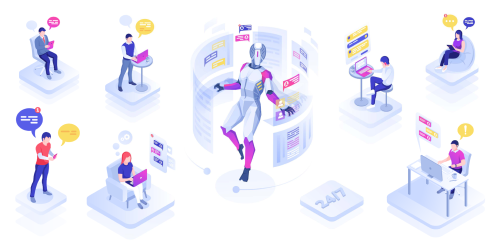Key Customer Service Metrics Every Business Should Measure
In today's competitive landscape, delivering exceptional customer service isn't just a bonus—it's a necessity for success. As businesses strive to meet and exceed customer expectations, understanding and measuring key customer service metrics play a crucial role in evaluating performance, identifying areas for improvement, and driving sustainable growth. Let's explore some of the most important customer service metrics that businesses should prioritize.
Introduction
Importance of Customer Service in Today's Business Landscape
In today's hyper-connected and competitive business environment, customer service has emerged as a cornerstone of success. Customers now wield unprecedented power, with the ability to amplify their opinions and experiences across various online platforms, influencing the perceptions and decisions of others. As a result, businesses are under immense pressure to deliver exceptional service experiences that not only meet but exceed customer expectations.
Exceptional customer service is no longer viewed as a luxury but rather as a fundamental requirement for sustainable growth and success. Beyond simply resolving inquiries or issues, outstanding customer service entails building meaningful relationships, fostering loyalty, and creating memorable experiences that differentiate a brand from its competitors.
Businesses that prioritize good customer service stand to benefit in numerous ways. Satisfied customers are more likely to become loyal advocates, recommending the brand to others and contributing to positive word-of-mouth marketing. Moreover, loyal customers tend to spend more, resulting in increased revenue and profitability over time. Conversely, neglecting important customer service metric can lead to dissatisfied customers, increased customer churn out rates, and damage to the brand's reputation, ultimately impacting the bottom line.
Role of Customer Service Metrics in Evaluating Performance and Driving Success
Effective customer service management requires not only a commitment to excellence but also a systematic approach to monitoring, measuring, and optimizing customer service performance. This is where customer service metrics play a pivotal role. Customer service metrics provide quantifiable insights into various aspects of customer service operations and delivery, enabling businesses to assess performance, identify areas for improvement, and make data-driven decisions.
By measuring key performance indicators (KPIs) such as first response time, average resolution time, customer churn rate, customer satisfaction scores %, and net promoter scores, businesses can gain a comprehensive understanding of their service quality and customer satisfaction levels. These metrics serve as valuable barometers of success, allowing businesses to gauge their performance relative to benchmarks, set goals for improvement, and track progress over time.
Moreover, customer service metrics facilitate accountability and transparency within an organization, enabling customer service teams to align their efforts towards common objectives and prioritize initiatives that have the greatest impact on customer satisfaction and loyalty. By leveraging customer service metrics effectively, businesses can not only identify areas of strength and weakness but also implement targeted strategies to enhance service quality, optimize resource allocation, and ultimately drive sustainable success in today's competitive marketplace.
Understanding Key Customer Service Metrics
Overview of the Top Customer Service Metrics
In the realm of customer service management, several key metrics serve as vital indicators of performance and satisfaction. These metrics provide valuable insights into various aspects of the customer experience and help organizations gauge the effectiveness of their customer service efforts and delivery efforts. Some of the top customer service metrics include:
1. First Response Time (FRT): FRT measures the time it takes for a customer inquiry or issue to receive an initial response from a support agent. It reflects the speed and efficiency with which various customer service requests and customer queries, are addressed, directly impacting customer satisfaction and perception of service quality.
2. Average Resolution Time (ART): ART tracks the average time taken to resolve customer inquiries or issues from the initial contact to average support ticket resolution time. It highlights the efficiency of support processes and the effectiveness of problem-solving capabilities, influencing customer satisfaction and operational efficiency.
3. Customer Satisfaction Score (CSAT): CSAT measures customer satisfaction levels based on feedback collected through surveys or direct interactions. It provides insights into overall service quality, customer sentiment, and areas for improvement, guiding efforts to enhance satisfaction and loyalty.
4. Net Promoter Score (NPS): NPS quantifies customer loyalty and advocacy by asking customers how likely they are to recommend the company to others. It gauges brand perception, identifies promoters and detractors, and informs strategies for fostering customer loyalty and retention.
5. Customer Retention Rate: Customer retention rate measures the percentage of new customers, who continue to do business with the company over a specified period. It reflects customer loyalty, customer satisfaction surveys, and the effectiveness of retention efforts, influencing long-term revenue and profitability.
6. First Contact Resolution (FCR): FCR evaluates the percentage of customer issues resolved during the initial contact with the customer support team. It indicates efficiency in problem resolution, reduces customer effort, and enhances overall customer service quality and satisfaction.
7. Service Level Agreement (SLA) Compliance: SLA compliance measures the percentage total number of tickets, customer inquiries or issues resolved within predefined service level agreements. It ensures service delivery meets established standards, builds trust, and maintains customer satisfaction.
8. Customer Effort Score (CES): CES assesses the ease with which customers can interact with a company to resolve their queries or issues. It focuses on minimizing customer effort, enhancing satisfaction, and fostering loyalty by streamlining customer support requests and processes.
Importance of Each Metric in Assessing Service Quality and Customer Satisfaction
Each customer service metric plays a unique role in evaluating service quality, customer satisfaction, and the overall customer experience. Understanding and analyzing these customer service metrics important enable organizations to:
- Identify areas for improvement and prioritize efforts to enhance customer service experience and delivery.
- Measure the effectiveness of customer service strategies and initiatives.
- Track progress towards performance goals and benchmarks.
- Make data-driven decisions to optimize resource allocation and operational efficiency.
- Cultivate customer loyalty, retention, and advocacy through targeted interventions and improvements.
By comprehensively evaluating and leveraging key customer service metrics, organizations can proactively address customer needs, exceed expectations, and ultimately, drive sustainable success in today's competitive marketplace.
First Contact Resolution (FCR)
Exploring the Concept of FCR and Its Importance in Customer Service
First Contact Resolution (FCR) is a crucial customer service metric that measures the percentage of customer inquiries or issues resolved during the initial contact with customer support, without the need for escalation or follow-up. FCR is a key indicator of customer service staff efficiency and effectiveness, reflecting the ability of support agents to address customer needs promptly and satisfactorily. High FCR rates indicate that customers receive timely and comprehensive assistance, leading to improved satisfaction and loyalty.
FCR is important in customer service because it directly impacts customer experience and operational efficiency. Resolving issues on the first contact minimizes customer effort, reduces frustration, and enhances overall satisfaction. It also optimizes resource utilization by minimizing the need for repeat interactions and reducing support costs. Additionally, high FCR rates contribute to positive word-of-mouth and reputation, as satisfied customers are more likely to recommend the company to others.
Benefits of Achieving High FCR Rates
Achieving high FCR rates offers several benefits to both customers and organizations:
1. Improved Customer Satisfaction: Resolving issues on the first contact eliminates the need for customers to follow up multiple times, leading to higher satisfaction levels.
2. Increased Customer Loyalty: Efficient and effective resolution of customer issues fosters loyalty and strengthens relationships with customers.
3. Enhanced Operational Efficiency: Minimizing repeat interactions reduces the workload on more customer support agents and teams, enabling them to handle more inquiries and improve productivity.
4. Cost Savings: Lowering the number of interactions per inquiry reduces support costs associated with staffing, training, and resources.
5. Positive Reputation: Consistently achieving high FCR rates enhances the company's reputation for excellent customer service and technical support teams, attracting new customers and retaining existing ones.
Implementing Tactics to Enhance FCR and Streamline Support Processes
To enhance FCR and streamline support processes, organizations can implement the following tactics:
1. Agent Training: Provide comprehensive training to support agents to equip them with the skills and knowledge needed to resolve a wide range of customer inquiries efficiently.
2. Knowledge Management: Implement a centralized knowledge base or resource center where agents can access information, FAQs, troubleshooting guides, and best practices to assist customers effectively.
3. Empowerment and Decision-Making Authority: Empower frontline agents with decision-making authority and resources to address customer issues without unnecessary delays or escalations.
4. Process Optimization: Continuously review and optimize support processes to identify and eliminate bottlenecks, streamline workflows, and reduce resolution times.
5. Customer Feedback and Analysis: Solicit feedback from customers to identify common issues, pain points, and opportunities for improvement. Analyze customer feedback and FCR metrics to identify trends and implement targeted interventions.
By prioritizing FCR and implementing tactics to enhance support processes, organizations can improve customer satisfaction, loyalty, and operational efficiency. Investing in FCR initiatives not only benefits customers but also contributes to the organization's overall success and competitiveness in the marketplace.
Service Level Agreement (SLA) Compliance

Defining SLAs and Their Role in Setting Service Expectations
Service Level Agreements (SLAs) are contractual agreements between a service provider and its customers that outline the level of service expected and the metrics by which that service will be measured. SLAs define parameters such as response times, resolution times, uptime guarantees, and quality standards. They play a crucial role in setting clear expectations for service delivery and ensuring accountability between the provider and the customer. By establishing agreed-upon benchmarks and performance targets, SLAs help align service delivery with customer needs and business objectives.
Monitoring SLA Compliance to Ensure Service Delivery Meets Standards
Monitoring SLA compliance is essential to ensure that service delivery meets agreed-upon standards and expectations. By tracking key performance indicators outlined in SLAs, organizations can assess their performance against established benchmarks and identify areas for improvement. Continuous monitoring allows for early detection of deviations from SLA targets, enabling proactive intervention to address issues and prevent service disruptions. Regular reporting on SLA performance promotes transparency and accountability, fostering trust and confidence between the service provider and its customers.
Strategies for Improving SLA Compliance and Meeting Customer Expectations
To improve SLA compliance and meet customer expectations, organizations can implement the following strategies:
1. Clear Communication: Clearly communicate SLA terms, expectations, and key performance indicator metrics to both internal teams and customers. Ensure that everyone understands their roles and responsibilities in meeting SLA targets.
2. Performance Monitoring and Reporting: Implement robust monitoring systems to track SLA performance in real-time. Use performance data to generate regular reports and dashboards that provide insights into SLA compliance and highlight areas for improvement.
3. Process Optimization: Review service delivery processes and identify opportunities to streamline workflows, reduce bottlenecks, and improve efficiency. Automate repetitive tasks and implement best practices to ensure consistent and timely service delivery.
4. Resource Allocation: Allocate resources effectively to ensure that customer service teams and delivery and support teams have the necessary tools, skills, and capacity to meet SLA requirements. Monitor workload and staffing levels to prevent resource shortages and ensure timely response to customer inquiries and requests.
5. Continuous Improvement: Foster a culture of continuous improvement by regularly reviewing SLA performance, soliciting feedback from customers, and implementing corrective actions as needed. Encourage collaboration and knowledge sharing among teams to identify innovative solutions and best practices for meeting SLA targets.
By prioritizing SLA compliance and implementing strategies to improve service delivery, organizations can enhance customer satisfaction, build trust and loyalty, and maintain a competitive edge in the marketplace. Effective SLA management not only strengthens customer relationships but also drives business success by ensuring consistent and high-quality service experiences.
Customer Effort Score (CES)
Understanding CES and Its Significance in Evaluating Customer Experiences
The Customer Effort Score (CES) is a metric used to measure the ease with which customers feel they can interact with a company to resolve their queries or issues. Unlike traditional customer satisfaction metrics, CES focuses specifically on the amount of effort customers must exert to get their concerns addressed. A low CES score indicates that customers find it easy to engage with a company, while a high score suggests that customers encounter significant obstacles or friction in their interactions.
CES is significant in evaluating customer experiences because it provides insights into the level of convenience and efficiency customers experience when seeking support or assistance. Research has shown that reducing customer effort can have a substantial impact on satisfaction, loyalty, and retention. Therefore, understanding and optimizing CES is essential for organizations aiming to deliver exceptional service experiences and build strong customer relationships.
Minimizing Customer Effort to Enhance Satisfaction and Loyalty
Minimizing customer effort is crucial for enhancing satisfaction and fostering loyalty. When customers encounter obstacles or complexities in their interactions with a company, they are more likely to become frustrated, dissatisfied, and even consider switching to competitors. By streamlining processes, reducing friction, and making it easy for customers to get the assistance they need, organizations can create positive experiences that keep happy customers coming back.
Strategies for minimizing customer effort may include:
1. Simplifying Processes: Streamline processes and procedures to make it easier for customers to navigate and complete tasks, such as placing an order, resolving an issue, or contacting the customer service team or representatives for support.
2. Enhancing Self-Service Options: Invest in self-service channels and resources, such as knowledge bases, FAQs, and online troubleshooting tools, to empower customers to find answers and solutions independently.
3. Improving Communication Channels: Offer multiple communication channels, such as phone, email, live chat, and social media, and ensure they are accessible, responsive, and user-friendly.
4. Providing Personalized Support: Leverage customer data and insights to personalize customer service interactions and tailor support solutions to individual needs and preferences.
5. Proactive Issue Resolution: Anticipate and address customer needs proactively, such as providing proactive notifications, updates, or recommendations based on past behavior or preferences.
Implementing Measures to Reduce Customer Effort and Improve CES Scores
To reduce customer effort and improve CES scores, organizations can implement various measures, including:
1. Conducting Customer Journey Mapping: Identify pain points, bottlenecks, and areas of friction in the customer journey and implement changes to streamline processes and improve the overall experience.
2. Gathering Feedback: Solicit feedback from customers through surveys, feedback forms, or post-interaction surveys to understand their experiences, identify areas for improvement, and measure CES scores.
3. Monitoring and Analyzing Data: Track customer interactions, behaviors, and satisfaction metrics to identify trends, patterns, and areas of opportunity for reducing customer effort.
4. Implementing Process Improvements: Use customer feedback and data insights to implement process improvements, such as simplifying forms, reducing wait times, or automating repetitive tasks.
5. Training and Empowering Employees: Provide training and support to frontline employees to equip them with the skills, knowledge, and resources needed to deliver efficient and effective customer service experiences.
By prioritizing customer effort reduction and optimizing the customer experience, organizations can enhance track customer satisfaction and, foster loyalty, and ultimately, drive business success.
Agent Performance Metrics

Overview of Key Agent Performance Metrics
In the realm of customer service management, assessing agent performance is crucial for delivering exceptional service and maintaining high levels of customer satisfaction. Several key metrics are used to evaluate the effectiveness and efficiency of a customer support team or agents. Some of the key customer service agent and performance metrics include:
1. Response Time: Response time measures the speed with which agents respond to customer inquiries or issues. It reflects the level of attentiveness and urgency in addressing customer requests and needs.
2. Resolution Time: Resolution time tracks the average time taken by agents to resolve customer inquiries or issues. It indicates the efficiency and effectiveness of problem-solving capabilities.
3. Customer Satisfaction Rating: Customer satisfaction rating reflects the level of satisfaction expressed by customers after interacting with an agent. It provides direct feedback on the quality of customer service agents have delivered.
4. First Contact Resolution Rate: First contact resolution rate measures the percentage of customer issues resolved during the initial interaction with an agent. It indicates the ability of agents to efficiently address customer needs without the need for escalation or follow-up.
5. Average Handling Time: Average handling time tracks the average number and duration of customer interactions handled by agents across the total number of tickets. It includes the time spent on responding to inquiries, resolving issues, and providing assistance.
6. Adherence to Procedures and Guidelines: Adherence to procedures and guidelines evaluates the extent to which agents comply with established protocols, policies, and best practices. It ensures consistency and quality in service delivery.
Importance of Tracking Agent Performance in Delivering Exceptional Service
Tracking agent performance is essential for maintaining high standards of service delivery and ensuring customer satisfaction. By monitoring key performance metrics, organizations can:
- Identify top-performing agents and recognize their contributions.
- Identify areas for improvement and provide targeted training and coaching to underperforming agents.
- Optimize resource allocation and staffing levels based on workload and performance metrics.
- Enhance accountability and transparency within the support team.
- Identify trends and patterns in customer inquiries to inform product or service improvements.
- Drive continuous improvement in service quality and customer experiences.
Strategies for Optimizing Agent Performance and Enhancing Customer Experiences
To optimize agent performance and enhance customer experiences, organizations can implement the following strategies:
- Provide comprehensive training and ongoing professional development opportunities to empower agents with the knowledge and skills needed to excel in their roles.
- Implement performance incentives and recognition programs to motivate agents and reward top performers.
- Foster a supportive and collaborative work environment that encourages knowledge sharing, collaboration, and teamwork.
- Leverage technology and automation tools to streamline workflows, reduce manual tasks, and enhance productivity.
- Solicit feedback from agents and customers to identify areas for improvement and implement targeted interventions.
- Establish clear performance goals and expectations, and regularly communicate feedback and performance evaluations to agents.
By prioritizing agent performance and implementing strategies to optimize performance, organizations can deliver exceptional customer service experiences that drive customer satisfaction, loyalty, and long-term success.
Conclusion
Recap of Key Customer Service Metrics Discussed
Throughout this article, we have explored a variety of key customer service metrics that are instrumental in evaluating performance, gauging customer satisfaction, and customer lifetime value and driving success. These right customer service metrics include:
1. First Response Time (FRT)
2. Average Resolution Time (ART)
3. Customer Satisfaction Score (CSAT)
4. Net Promoter Score (NPS)
5. Customer Retention Rate
6. First Contact Resolution (FCR)
7. Service Level Agreement (SLA) Compliance
8. Customer Effort Score (CES)
9. Issue Escalation Rate
10. Agent Performance Metrics
Each metric provides valuable insights into different aspects of the customer experience and service delivery, enabling organizations to identify areas for improvement and implement targeted strategies to enhance overall performance.
Importance of Measuring and Optimizing Metrics for Success
Measuring and optimizing each customer support metric and service metrics is critical for achieving success in today's competitive business landscape. By systematically tracking and analyzing key customer support metrics, organizations can:
- Gain a deeper understanding of customer needs, preferences, and pain points.
- Identify opportunities for improvement and implement targeted initiatives to enhance service quality and customer satisfaction.
- Monitor progress towards performance goals and benchmarks, enabling continuous improvement and refinement of service delivery strategies.
- Optimize resource allocation, staffing levels, and operational efficiency to meet customer demands effectively.
- Cultivate customer loyalty, retention, and advocacy through exceptional customer service team experiences that exceed expectations.
Final Thoughts on Driving Exceptional Customer Service Through Metric-Driven Strategies
In today's digital age, delivering exceptional customer service requires a proactive, data-driven approach. By leveraging key customer service metrics, organizations can gain actionable insights into customer behavior and preferences, enabling them to tailor their service delivery strategies to meet evolving needs and expectations. However, it's essential to remember that metrics are just one piece of the puzzle. To truly drive exceptional customer service, organizations must combine metric-driven insights with empathy, creativity, and a genuine commitment to customer satisfaction. By prioritizing the customer experience and continually striving for excellence, organizations can build lasting relationships, foster loyalty, and achieve sustainable success in today's competitive marketplace.





